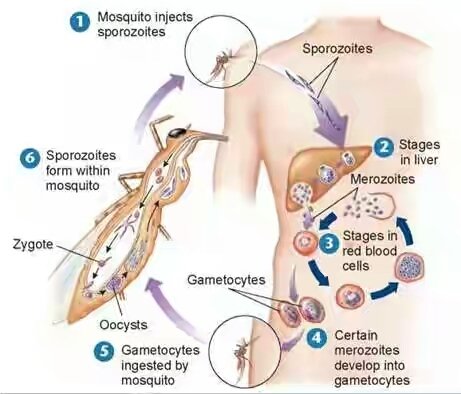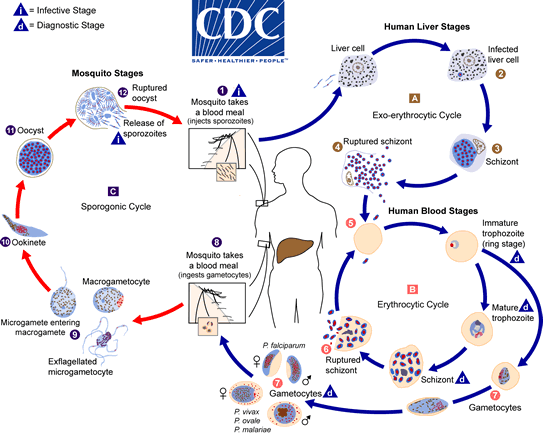Many of us knows that malaria parasite is transmitted to us through mosquitoes bite but fail to know the species causing it. In my article today, I will be talking deep on Plasmodium; a Coccidia causing intracellular parasite in man and animal.

Source: http://schoolbag.info/biology/living/140.html
Plasmodium
The species of these genus infect both man and animal. In man, it cause malaria disease; the commonest parasitic disease of man in tropical and subtropical region.
It has been regarded as the greatest killer of man with about 300-500 million people and 2.5million ending in death each year.
All species of Plasmodium causing human malaria disease are:
Plasmodium ovale: This occur in tropical Africa with sporadic cases in Asia and far East. The infection causes mild clinical symptoms except that it is difficult to eradicate, persisting for years due to relapse from hypnozoites in the liver.
Plasmodium falciparum: It is the most common malaria parasite in tropical Africa accounting for about 50% of all malaria cases.
It is the most pathogenic malaria parasite responsible for nearly all the malaria related to the death of so many people in the world but early symptoms are easily controlled.
Plasmodium vivax: This is a predominantly temperate species though they are patches of infection in some tropical countries. It is responsible for about 43% of all the malaria infection in the world.
Like P.ovale, it also causes mild infection due to liver hypnozoites.
Plasmodium malariae: It causes the least severe malaria infection and is widely distributed, extending over the tropic and subtropical region in India and Guyana.
This four species of plasmodium causing human malaria diseases is transmitted by female mosquitoes of the Genus-Anopheles, Order-Diptera and Family-Cullicidae.
Life Cycle
There are variation in there development phases, pathological effects and morphological features in developed stages with different species of plasmodium.
The developmental phases are:
- Schizogony (asexual phase)
- Gametogony (sexual phase)
- Sporogony (asexual phase)
Gametogony and spotogony phases occurs in the insect vector while Schizogony development occurs in two stages in man.

Source: https://www.cdc.gov/dpdx/malaria/index.html
This two stages in man are:
- Pre-erythrocytic cycle (outside the red blood cell,usually the liver cell.
The pre-erythrocytic cycle starts whenever the infective form is introduced into the blood stream within 1-3hrs, circulate round the lymphatic vessels to reach the liver then later penetrate the liver cells (hepatocytes) and the kuffner cells.
It develop into a trophozoites then grow to become a pre erythrocytic schizont.
The schizont ruptures within 5-20days of infection depending on the species to merozoite known as cryptozoite.
In P.vivax and P.ovale, the hepatocytes invading sporozoites differentiates into hypnozoites or tissue schizonts of various sizes that remain dormant for a period in the hepatocytes until a later time when normal schizogony growth is reduced.
The dormant phases is responsible to the long time relapse know with these species.
The cryptozoite liberated into the stream and may either be engulfed and destroy by hepatocytes or invade the red blood sell to initiate erythrocytic cycle.
This Schizogony process is repeated several times to build up a large number of merozoites until the process is slowed down by the host immune response.
- Erythrocytic/Intra corpuscular cycle (inside the red blood cell)
The merozoite which successfully penetrate into the R.B.C develops into a trophozoites, a ring shaped structure formed by the displacement of the cytoplasm and nucleus to the periphery of a central vacuole.
These feed on the haemoglobin of the R.B.C and releases a toxic substance called Haemozoin (malaria pigment) as product of digestion.
During this process, it develops into a more or less spherical shape leaving the host R.B.C with an abnormal appearance of been enlarged,decolorized and stripped.
The trophozoite further grows into a rounded schizont which later divides to produce merozoite called meta-merozoite that are released into the blood stream when the host cell ruptures.
The rupturing activity of the host cell is periodic and synchronised for each species with P. vivax, P. ovale and P. falciparum rupturing every 48hrs (tertian) while P.malariae occurs every 72hrs (quartans).
The destruction of the red blood cell is associated with the release of parasite metabolic waste produce which result in episodic chills and paroxysms of fever that characterized the disease.
** watch out for the continuation of this article in my next post and thanks for reading...**
Congratulations! This post has been upvoted from the communal account, @minnowsupport, by greenlife500eu from the Minnow Support Project. It's a witness project run by aggroed, ausbitbank, teamsteem, theprophet0, and someguy123. The goal is to help Steemit grow by supporting Minnows and creating a social network. Please find us in the Peace, Abundance, and Liberty Network (PALnet) Discord Channel. It's a completely public and open space to all members of the Steemit community who voluntarily choose to be there.
If you like what we're doing please upvote this comment so we can continue to build the community account that's supporting all members.
Nice one
So informative
Big bros, this is good. Malaria has claimed many lives, knowledge of it and even the preventive measures to take isnt a bad idea. well done
Thanks, very educative cause malaria is one of the highest cause of death in Africa.